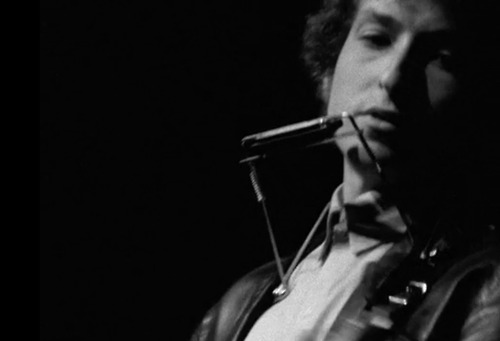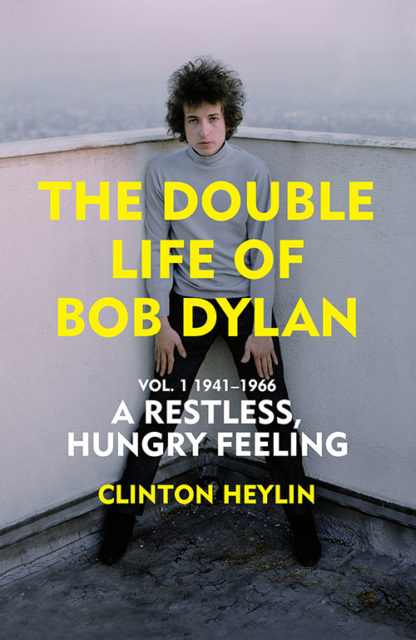
THE DOUBLE LIFE OF BOB DYLAN: VOLUME 1, 1941-1966
By Clinton Heylin (Penguin Random House Australia, h/b)
Reviewed by Des Cowley.
It is somehow fitting that I’m writing this on the day of Bob Dylan’s 80th birthday. Like many, his music has formed a soundtrack to my life, from childhood onwards. Chances are I first heard his music via the then popular Peter, Paul & Mary; though I distinctly recall the six-minutes plus shock and awe of ‘Like a Rolling Stone’, with its enigmatic and convoluted lyrics, blasting from my family radio in 1965. How many artists have achieved such longevity, continuing to deliver high points in every decade of a sixty-year career? Who else could drop a seventeen-minute opus like ‘Murder Most Foul’ so late in the day? Neil, Joni, Van? As Clinton Heylin might say: I think not.

Heylin is no neophyte when it comes to Dylan, having penned some ten books to date, including his monumental Behind the Shades. It’s surely a testament to Dylan’s inexhaustibility that Heylin felt the need to return to the well. His Double Life, though, is not some last-minute footnote, but instead the first of a projected three volumes that sees him returning to basics, re-building his story from the ground up. The original impetus came from the newly founded Bob Dylan archive in Tulsa, a trove of some 6,000 (or 100,000, depending on your source) largely unseen notebooks, manuscripts, and correspondence. Dylan supposedly picked up a cool $15-20 million for the material, loose change in comparison to the more recent sale of his songbook.
Heylin comes out of his corner fighting at the get-go, castigating other Dylan biographers for their failings.
Heylin comes out of his corner fighting at the get-go, castigating other Dylan biographers for their failings. This has already engendered a very public spat with Howard Sounes, who responded by dubbing Heylin’s books ‘long and baggy’. Coming across all ornery, Heylin is intent on establishing his credentials from the outset, perhaps understandable given he’s about to invest a decade of his life delivering what he hopes will be the final word on all things Bob. So, what do we get? We get nearly five hundred pages devoted to the first six years of Dylan’s career (with brief side-visits to Duluth and Hibbing, Minnesota), from the time he arrived in Greenwich Village, through to his landing back on home soil, exhausted, after the controversial 1966 European tour. Few careers could stand up to that level of scrutiny, but when it comes to Dylan, the well truly does feel bottomless.
Heylin argues the importance of returning to the sources, the archive. Almost everyone who had anything to do with Dylan has already published their version, often years after the fact. Many are now dead. Others have wildly embellished their roles, seeking centre-stage. When Dylan first got off the bus in New York, he had already begun the process of obfuscation, inventing an entire fictional past for himself, including his name. His later Chronicles, while a stunning literary work, plays fast and loose with the truth. One of the strengths of Heylin’s book is that he endeavours to separate the wheat from the chaff, laying conflicting accounts side by side, and making the call based on available evidence.
The Dylan that emerges from Heylin’s book is indisputably possessed by genius. At barely twenty, he was penning songs so rapidly they were often forgotten before he’d written them down.
The Dylan that emerges from Heylin’s book is indisputably possessed by genius. At barely twenty, he was penning songs so rapidly they were often forgotten before he’d written them down. And let’s face it, the songs Dylan left off his early albums would have carved out a successful career for any other artist. Steve Wilson remembers: “His ability to both remember complex lyrics of great length, and to scan words so they fit the meter of the line, was highly unusual. He had little need to practice or work up his material, because it arrived in his head largely formed”. Several refer to him as a ‘sponge’, able to absorb everything around him, turning it into song. Sitting at his typewriter, he could knock out long, complex lyrical poems, while around him friends chatted and drank. Of course, not everyone twigged to it immediately, but the switched-on ones did. Victor Maymudes: “He was like an electrical condenser, a capacitor filling up with information and ultimately exploding on paper with songs.”
One can’t help but feel a certain excitement reading about this period of Dylan’s life. The change and momentum are so great it’s like watching a film speeded up. Just four short years separate the release of Bob Dylan, a derivative if promising folk-inspired album, from Blonde on Blonde, one of the seminal recordings of the 20th century. Heylin has to work hard to keep up: Gerdes Folk City, Suzie Rotolo, John Hammond, Columbia, Joan Baez, Carnegie Hall, trips to London, DA Pennebaker, Sara Lownds, Newport. And that’s just for starters. Sure, much of this story is familiar, but it is the detail that keeps us reading. Throughout, it’s as if Dylan is trying on personalities, like others might try on a new suit: Woody Guthrie folkie, ‘voice of a generation’, leather-clad sneering rock n’ roller. If they were all Dylan, we can equally say none of them were. While Heylin circles him, studying him from all sides, the genuine Dylan – if there is such a thing – remains fixed behind his shades.
Heylin’s books ends with Dylan’s 1966 tour, exhaustively documented on the 36-CD box set issued in 2016. To this day, the hostility shown to Dylan’s electric music remains perplexing, especially given the UK was in the grip of Beatlemania (clearly there is no greater fury than a folkie scorned). The animosity, Heylin makes clear, was by and large a beat up by the British press, but the reality is Dylan was running on empty (or at least amphetamines). Heylin’s initial volume recounts an oft told tale, and while we already know what he has in store for us in the next one – a motorcycle accident, seclusion, the Basement Tapes – it doesn’t prevent my looking forward to it. If, as Dylan tells us (echoing Walt Whitman), he contains multitudes, then we can expect writers to be telling his tale for as long as stories are told.

